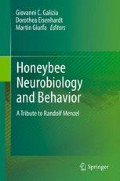Abstract
The waggle dance of the honey bee is one of the most extensively studied forms of animal communication, but only recently have investigators closely examined its adaptive significance, that is, how it improves the foraging efficiency of a honey bee colony. Studies at the colony level, in which investigators have compared the effectiveness of food collection between colonies with normal and disoriented dances, have found that the waggle dance improves a colony’s foraging performance when food sources are hard to find, variable in profitability, and ephemeral. Studies at the individual level, in which investigators compared the effectiveness of food collection between bees that do and do not use waggle dance information to find new food sources (recruits and scouts) have found that following a waggle dance to find a new food source raises the cost of doing so but that this cost is outweighed by a benefit in the quality of the food source that is found. The emerging picture of the adaptive significance of the honey bee’s waggle dance is that it makes it possible for a colony to function as a collective decision-making unit that is skilled at deciding how to distribute its forager workforce over an array of widely scattered, highly variable, and ever changing patches of flowers.
Access this chapter
Tax calculation will be finalised at checkout
Purchases are for personal use only
References
Beekman M, Bin Lew J (2008) Foraging in honeybees – when does it pay to dance? Behav Ecol 19(2):255–262
Beekman M, Ratnieks FLW (2000) Long-range foraging by the honey-bee, Apis mellifera L. Funct Ecol 14(4):490–496
Biesmeijer JC, Seeley TD (2005) The use of waggle dance information by honey bees throughout their foraging careers. Behav Ecol Sociobiol 59(1):133–142
Biesmeijer JC, de Vries H (2001) Exploration and exploitation of food sources by social insect colonies: a revision of the scout-recruit concept. Behav Ecol Sociobiol 49(2–3):89–99
De Marco RJ, Farina WM (2001) Changes in food source profitability affect the trophallactic and dance behavior of forager honeybees (Apis mellifera L.). Behav Ecol Sociobiol 50(5):441–449
Dornhaus A, Chittka L (2004) Why do honey bees dance? Behav Ecol Sociobiol 55(4):395–401
Dyer FC (2002) The biology of the dance language. Annu Rev Entomol 47:917–949
Esch HE, Bastian JA (1970) How do newly recruited honeybees approach a food site. Z vergl Physiol 68:175–181
Esch HE, Zhang SW, Srinivasan MV, Tautz J (2001) Honeybee dances communicate distances measured by optic flow. Nature 411(6837):581–583
Gardner KE, Seeley TD, Calderone NW (2007) Hypotheses on the adaptiveness or non-adaptiveness of the directional imprecision in the honey bee’s waggle dance (Hymenoptera: Apidae: Apis mellifera). Entomol Gen 29(2–4):285–298
Gil M, Farina WM (2002) Foraging reactivation in the honeybee Apis mellifera L.: factors affecting the return to known nectar sources. Naturwissenschaften 89(7):322–325
Gould JL (1975) Honey bee recruitment: the dance-language controversy. Science 189(4204):685–693
Grüter C, Balbuena MS, Farina WM (2008) Informational conflicts created by the waggle dance. Proc R Soc B 275(1640):1321–1327
Grüter C, Farina WM (2009) The honeybee waggle dance: can we follow the steps? Trends Ecol Evol 24(5):242–247
Johnson DL, Wenner AM (1966) A relationship between conditioning and communication in honey bees. Anim Behav 14(2):261–265
Krause J, Ruxton GD, Krause S (2010) Swarm intelligence in animals and humans. Trends Ecol Evol 25(1):28–34
Mautz D (1971) Communication effect of wag-tail dances of Apis mellifera carnica(pollm.). Z vergl Physiol 72(2):197–220
Menzel R, Giurfa M (2006) Dimensions of cognition in an insect, the honeybee. Behav Cogn Neurosci Rev 5(1):24–40
Michelsen A (2003) Karl von Frisch lecture. Signals and flexibility in the dance communication of honeybees. J Comp Physiol A 189(3):165–174
Reinhard J, Srinivasan MV, Zhang S (2004) Scent-triggered navigation in honeybees. Nature 427(6973):411
Ribbands CR (1954) Communication between honeybees. I: The response of crop-attached bees to the scent of their crop. Proc R Entomol Soc Lond A 30:1–3
Riley JR, Greggers U, Smith AD, Reynolds DR, Menzel R (2005) The flight paths of honeybees recruited by the waggle dance. Nature 435(7039):205–207
Seeley TD (1983) Division of labor between scouts and recruits in honeybee foraging. Behav Ecol Sociobiol 12:253–259
Seeley TD (1995) The wisdom of the hive. Harvard University Press, Cambridge
Seeley TD, Mikheyev AS, Pagano GJ (2000) Dancing bees tune both duration and rate of waggle-run production in relation to nectar-source profitability. J Comp Physiol A 186(9):813–819
Seeley TD, Visscher PK (1988) Assessing the benefits of cooperation in honeybee foraging – search costs, forage quality, and competitive ability. Behav Ecol Sociobiol 22(4):229–237
Sherman G, Visscher PK (2002) Honeybee colonies achieve fitness through dancing. Nature 419(6910):920–922
Tanner DA, Visscher PK (2010) Adaptation or constraint? Reference-dependent scatter in honey bee dances. Behav Ecol Sociobiol 64(7):1081–1086
Towne WF, Gould JL (1988) The spatial precision of the dance communication of honey bees. J Insect Behav 1:129–155
Visscher PK, Seeley TD (1982) Foraging strategy of honeybee colonies in a temperate deciduous forest. Ecology 63(6):1790–1801
von Frisch K (1946) Die Tänze der Bienen. Österreich Zool Z 1:1–48
von Frisch K (1967) The dance language and orientation of bees. Harvard University Press, Cambridge
von Frisch K (1968) The role of dances in recruiting bees to familiar sites. Anim Behav 16:531–533
Wenner AM, Wells PH (1990) Anatomy of a controversy: the question of a “language” among bees. Columbia University Press, New York
Author information
Authors and Affiliations
Corresponding author
Editor information
Editors and Affiliations
Rights and permissions
Copyright information
© 2012 Springer Science+Business Media B.V.
About this chapter
Cite this chapter
Seeley, T.D. (2012). Progress in Understanding How the Waggle Dance Improves the Foraging Efficiency of Honey Bee Colonies. In: Galizia, C., Eisenhardt, D., Giurfa, M. (eds) Honeybee Neurobiology and Behavior. Springer, Dordrecht. https://doi.org/10.1007/978-94-007-2099-2_7
Download citation
DOI: https://doi.org/10.1007/978-94-007-2099-2_7
Published:
Publisher Name: Springer, Dordrecht
Print ISBN: 978-94-007-2098-5
Online ISBN: 978-94-007-2099-2
eBook Packages: Biomedical and Life SciencesBiomedical and Life Sciences (R0)

